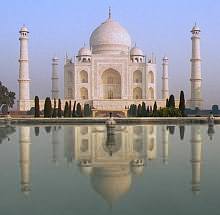You drive out of Delhi and it takes about 6 hours to reach Agra. This is where the Taj Mahal stands, waiting in sheer majesty to greet its visitors. But since we had reached Agra on a Friday, the monument is closed for public viewing. So we have lunch and then walk around Agra.
Agra also has its own Red Fort and Meena Bazaar. You see, before Akbar shifted his capital to Delhi, he had made Agra his seat of power. But because of water shortage and the fact that Delhi seemed more strategically situated to rule his vast empire, he moved base. Today, the Indian armed forces uses the Agra Fort to house soldiers.
But en route to Agra, we stop by Mathura, the birthplace of Lord Krishna. Here, the Brindavan temple is a pilgrim spot as one particular place in the vast temple complex is reportedly the exact spot where Lord Krishna was born. ISKON also has a beautiful temple constructed right next door. Mathura has a museum too, where people if they so wish, can get replicas made of some of the things that are on view there. But since all these places are almost in the heart of tiny villages, make sure to take along an extremely experienced driver.
Your first view of the Taj Mahal – that universally known monument built in remembrance of a beloved queen is such a stunner. Well, just as you step up the steps of the east gate, it's just suddenly there, as if it has always been waiting for you …. and you alone. The perfect symmetry of the Taj, framed in that gateway is mind-boggling. This was done, when architects were seers – extremely gifted and farsighted – who knew they were building monuments for the ages and not just as a passing trend.
Then you step down from the gate and walk through the Mughal gardens in front of the Taj. The gardens are flanked by four gates, as are all monuments that the Mughals built. But for security purposes, only the East gate is opened for admitting tourists. There are also rooms along the entire length and breadth of the complex, where earlier the workers who toiled on the Taj lived. It took 20,000 workers and 22 years to build the Taj and contrary to common knowledge, their hands were not cut off. It was more along the lines of the modern day contract. They promised the emperor Shah Jahan that they would never build another monument like this, ever, for anyone else.
As we get to the Taj, one realizes why the emperor wanted this to be one of its kind. The inlay work cut into the marble is so intricate, it astounds the mind. That explains the long years of work it took to build this tomb. All the inscriptions from the Quran are cut into marble and then filled in with coloured stones. These were originally precious and semi-precious stones, until the British stripped it clean. They clearly have a lot on their conscience!
These stones were shaved into extremely fine slivers and put into the carving with the help of thick glue. This glue was made of coal and various other substances, which only the descendants of those workers, who worked on the Taj know and pass on from generation to generation. It looks like green putty and yes, their descendants are still practising this art, but only on exquisitely divine Makhrana marble tables, counter tops, elephants, lamp stands, jewellery boxes, even eggs, along the line of Faberge eggs. The bigger pieces begin to retail at prices starting at Rs 1 lakh and above!
Tourists can visit these workshops and photograph these people at work. But remember to take a local for a guide along, who will know where to take you. Some of these table tops take two years in the making; so working on the Taj for 22 years is understandable!
Shah Jahan's queen, Mumtaz - whose real name was Arjamand Banu Begum - is buried directly under the famous dome of the Taj. Since her crypt is below ground, there are steps leading to it underground, but people are not allowed to go down, and it is sealed by a grill. But people literally get down on their knees and lift the grill to view the tomb. How appropriate, I thought, after all she was an empress and had we lived in the 18th century, we would have bowed to her royal highness!
It's truly a measure of one man's love for his wife. Being an emperor, he truly has preserved her memory in a time-defying manner. Who needs the West's Romeo and Juliet, when the greatest evidence of undying love lives on in the East.
Tourist tips
Agra is world-famous for its marble work, leather goods and carpets. The government offers subsidies to these industries; so pick up gorgeous stuff from here at much cheaper prices than anywhere else in India. Despite the implementation of VAT, with the export subsidies, these industries are entitled to, the goods still work out cheaper.
Places to shop
 For stunningly beautiful marble inlaid pieces: UP Handicrafts Palace, Fatehabad Road, Agra – 282001, India. Tel no: 562- 2232660/61/62/63. Fax: 91- 562-2330193. email: upcrafts@sancharnet.in Website: www.upcraftspalace.com
For stunningly beautiful marble inlaid pieces: UP Handicrafts Palace, Fatehabad Road, Agra – 282001, India. Tel no: 562- 2232660/61/62/63. Fax: 91- 562-2330193. email: upcrafts@sancharnet.in Website: www.upcraftspalace.com
For intricately hand knotted, lusciously soft carpets. The owner also custom-makes them for you, if you want a particular design!
Java Handicraft Export, Bansal Nagar, Fatehabad Road, Agra – 282001, Uttar Pradesh, India. Telefax: 0091-562-2333716. email: javacarpet@yahoo.com
Written for www.dancewithshadows.com
Agra also has its own Red Fort and Meena Bazaar. You see, before Akbar shifted his capital to Delhi, he had made Agra his seat of power. But because of water shortage and the fact that Delhi seemed more strategically situated to rule his vast empire, he moved base. Today, the Indian armed forces uses the Agra Fort to house soldiers.
But en route to Agra, we stop by Mathura, the birthplace of Lord Krishna. Here, the Brindavan temple is a pilgrim spot as one particular place in the vast temple complex is reportedly the exact spot where Lord Krishna was born. ISKON also has a beautiful temple constructed right next door. Mathura has a museum too, where people if they so wish, can get replicas made of some of the things that are on view there. But since all these places are almost in the heart of tiny villages, make sure to take along an extremely experienced driver.
Your first view of the Taj Mahal – that universally known monument built in remembrance of a beloved queen is such a stunner. Well, just as you step up the steps of the east gate, it's just suddenly there, as if it has always been waiting for you …. and you alone. The perfect symmetry of the Taj, framed in that gateway is mind-boggling. This was done, when architects were seers – extremely gifted and farsighted – who knew they were building monuments for the ages and not just as a passing trend.
Then you step down from the gate and walk through the Mughal gardens in front of the Taj. The gardens are flanked by four gates, as are all monuments that the Mughals built. But for security purposes, only the East gate is opened for admitting tourists. There are also rooms along the entire length and breadth of the complex, where earlier the workers who toiled on the Taj lived. It took 20,000 workers and 22 years to build the Taj and contrary to common knowledge, their hands were not cut off. It was more along the lines of the modern day contract. They promised the emperor Shah Jahan that they would never build another monument like this, ever, for anyone else.
As we get to the Taj, one realizes why the emperor wanted this to be one of its kind. The inlay work cut into the marble is so intricate, it astounds the mind. That explains the long years of work it took to build this tomb. All the inscriptions from the Quran are cut into marble and then filled in with coloured stones. These were originally precious and semi-precious stones, until the British stripped it clean. They clearly have a lot on their conscience!
These stones were shaved into extremely fine slivers and put into the carving with the help of thick glue. This glue was made of coal and various other substances, which only the descendants of those workers, who worked on the Taj know and pass on from generation to generation. It looks like green putty and yes, their descendants are still practising this art, but only on exquisitely divine Makhrana marble tables, counter tops, elephants, lamp stands, jewellery boxes, even eggs, along the line of Faberge eggs. The bigger pieces begin to retail at prices starting at Rs 1 lakh and above!
Tourists can visit these workshops and photograph these people at work. But remember to take a local for a guide along, who will know where to take you. Some of these table tops take two years in the making; so working on the Taj for 22 years is understandable!
Shah Jahan's queen, Mumtaz - whose real name was Arjamand Banu Begum - is buried directly under the famous dome of the Taj. Since her crypt is below ground, there are steps leading to it underground, but people are not allowed to go down, and it is sealed by a grill. But people literally get down on their knees and lift the grill to view the tomb. How appropriate, I thought, after all she was an empress and had we lived in the 18th century, we would have bowed to her royal highness!
It's truly a measure of one man's love for his wife. Being an emperor, he truly has preserved her memory in a time-defying manner. Who needs the West's Romeo and Juliet, when the greatest evidence of undying love lives on in the East.
Tourist tips
Agra is world-famous for its marble work, leather goods and carpets. The government offers subsidies to these industries; so pick up gorgeous stuff from here at much cheaper prices than anywhere else in India. Despite the implementation of VAT, with the export subsidies, these industries are entitled to, the goods still work out cheaper.
Places to shop
 For stunningly beautiful marble inlaid pieces: UP Handicrafts Palace, Fatehabad Road, Agra – 282001, India. Tel no: 562- 2232660/61/62/63. Fax: 91- 562-2330193. email: upcrafts@sancharnet.in Website: www.upcraftspalace.com
For stunningly beautiful marble inlaid pieces: UP Handicrafts Palace, Fatehabad Road, Agra – 282001, India. Tel no: 562- 2232660/61/62/63. Fax: 91- 562-2330193. email: upcrafts@sancharnet.in Website: www.upcraftspalace.com For intricately hand knotted, lusciously soft carpets. The owner also custom-makes them for you, if you want a particular design!
Java Handicraft Export, Bansal Nagar, Fatehabad Road, Agra – 282001, Uttar Pradesh, India. Telefax: 0091-562-2333716. email: javacarpet@yahoo.com
Written for www.dancewithshadows.com



No comments:
Post a Comment